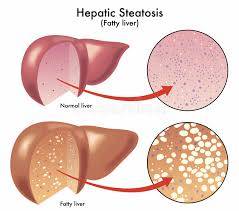Hepatic steatosis, commonly known as fatty liver, is a condition characterized by the accumulation of fat in the liver cells. Here are 20 potential factors related to hepatic steatosis, along with signs and symptoms, effects, and solutions:
**Causes:**
1. Obesity.
2. Insulin resistance.
3. Type 2 diabetes.
4. High intake of dietary fructose.
5. High dietary fat intake.
6. Metabolic syndrome.
7. Rapid weight loss.
8. Medications (e.g., corticosteroids, tamoxifen).
9. Alcohol consumption (alcoholic fatty liver disease).
10. Viral hepatitis (non-alcoholic fatty liver disease).
11. Poor diet.
12. Sedentary lifestyle.
13. Polycystic ovary syndrome.
14. Rapid weight gain.
15. High triglyceride levels.
16. Wilson's disease (rare genetic disorder).
17. Celiac disease.
18. Hypothyroidism.
19. Malnutrition.
20. Lipodystrophy (abnormal fat distribution).
**Signs and Symptoms:**
1. Fatigue.
2. Enlargement of the liver.
3. Abdominal discomfort (usually in the upper right side).
4. Jaundice (in severe cases).
5. Elevated liver enzymes.
6. Insulin resistance.
7. Unexplained weight loss.
8. Hepatomegaly (enlarged liver).
9. Ascites (fluid buildup in the abdomen).
10. Pruritus (itchy skin).
11. Dark urine.
12. Light-colored stools.
13. Abnormal lipid profiles.
14. Hypertension.
15. Palmar erythema (reddening of the palms).
16. Spider-like blood vessels on the skin.
17. Enlarged spleen (splenomegaly).
18. Cognitive changes (hepatic encephalopathy).
19. Increased susceptibility to infections.
20. Elevated blood sugar levels.
**Effects:**
1. Accumulation of fat in liver cells.
2. Non-alcoholic fatty liver disease (NAFLD).
3. Impaired liver function.
4. Progression to non-alcoholic steatohepatitis (NASH) in some cases.
5. Risk of cirrhosis in severe cases.
6. Increased risk of liver cancer.
7. Increased risk of cardiovascular disease.
8. Insulin resistance and diabetes.
9. Hepatic encephalopathy (cognitive changes).
10. Abdominal fluid buildup (ascites).
11. Elevated liver enzymes.
12. Cardiovascular complications.
13. Impaired lipid metabolism.
14. Hypertension.
15. Increased risk of infections.
16. Impaired quality of life.
17. Reduced life expectancy.
18. Risk of complications during surgery.
19. Risk of metabolic syndrome.
20. Psychological and mood issues.
**Solutions:**
1. Lifestyle changes, including a balanced diet and regular exercise.
2. Weight management and gradual weight loss (if overweight).
3. Management of underlying conditions (e.g., diabetes or high triglycerides).
4. Medications (e.g., statins) to manage lipid profiles.
5. Alcohol abstinence (if related to alcoholic fatty liver disease).
6. Avoiding medications that may exacerbate hepatic steatosis.
7. Management of insulin resistance.
8. Support from healthcare professionals.
9. Psychological support and counseling.
10. Support from family and friends.
11. Support groups for individuals with hepatic steatosis.
12. Regular medical monitoring.
13. Vaccinations to prevent infections.
14. Managing cardiovascular risk factors.
15. Liver transplant evaluation for severe cases.
16. Educational programs for healthcare professionals.
17. Public health initiatives to promote awareness.
18. Legal regulations and policies to reduce toxin exposure.
19. Avoiding exposure to environmental toxins.
20. Stress management techniques.
Management of hepatic steatosis primarily involves lifestyle changes and addressing underlying conditions. If you suspect you have hepatic steatosis or are at risk, consult a healthcare professional for evaluation and guidance.


